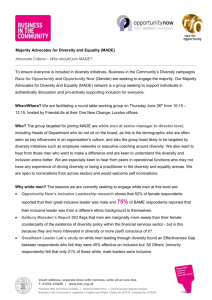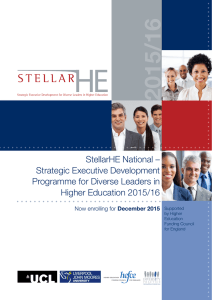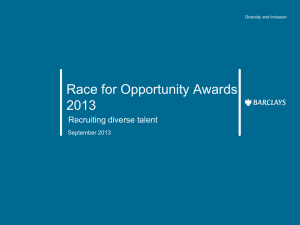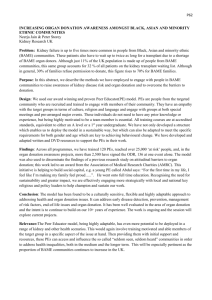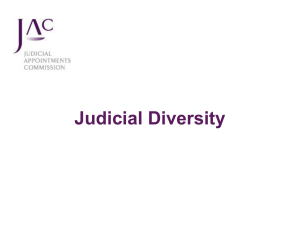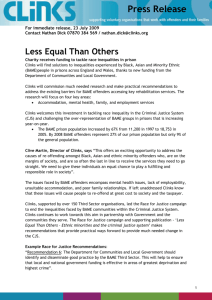INCLUSIVITY SUPPORTING BAME TRANS PEOPLE SABAH CHOUDREY 1
advertisement
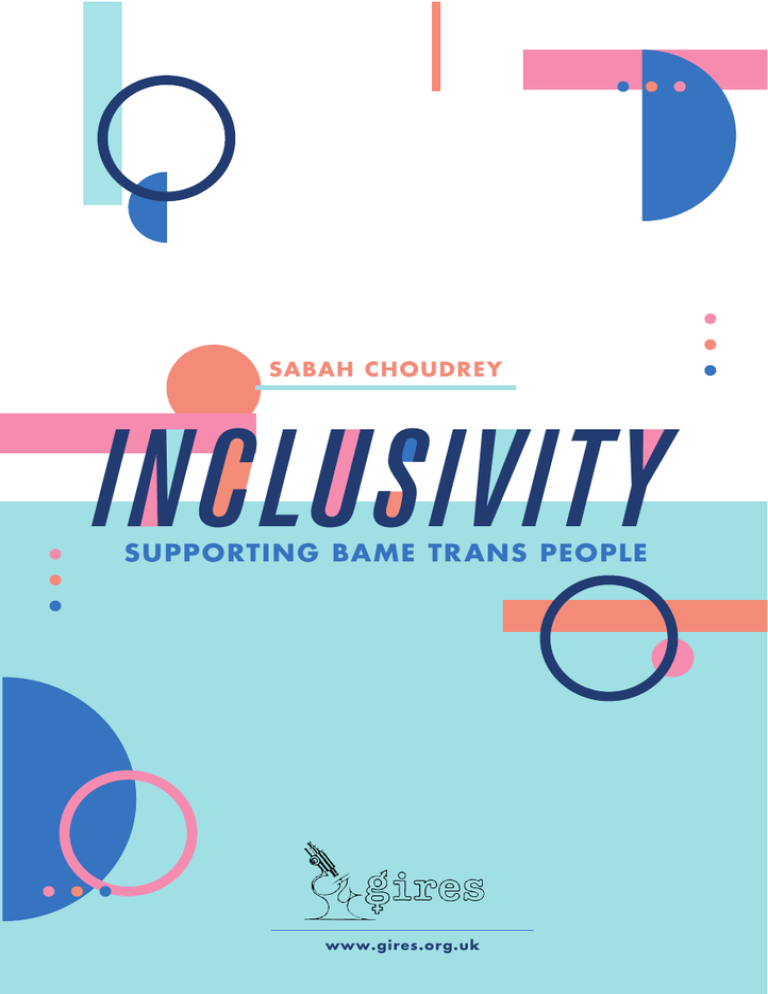
SABAH CHOUDREY INCLUSIVITY SUPPORTING BAME TR ANS PEOPLE www.gires.org.uk 1 By Xavier and Sabah Gendered Intelligence Mentoring Support for BAME Trans 2 Youth CONTENTS Foreword 1.Terminology 2.Introduction 3.Intersectionality 4. Life in the UK for a BAME trans person 5.Training 6.Signposting 7. BAME LGBT UK Database 8.Practicalities a.Website b. Venue and location c. Language and distribution (advertising) d. Partnership work and outreach e. Follow-up 9. Creating a Safe Space a. BAME and trans only spaces b.Acknowledgement c. Media Representation d. Understanding racism and cultural appropriation e. UK centred information and resources 10. Checklist for workers/group leaders 11. Top 10 Tips for Being a Good Ally to BAME Trans People 12. What does inclusivity look like? 13. What does tokenism look like? 14.Resources 15. Further reading 16. Thank yous 3 FOREWORD The Gender Identity Research and Education Society (GIRES) is pleased to have had the opportunity to fund this important guide on supporting BAME trans people and is most grateful to Sabah Choudrey for the sensitivity and professionalism demonstrated in developing this TERMINOLOGY LGBTQ Lesbian, gay, bisexual, trans, queer TRANS an umbrella term for all transgender, gender non-conforming, and non-binary identities BAME Black, Asian and minority ethnic (including, African, Middle Eastern, indigenous and mixed race identities) sometimes written as ‘BME’ POC people of colour/person of colour (a political term to describe any person who is not white) QTIPOC queer, trans and intersex people of colour/person of colour 4 Languages within communities differ greatly, across generations and locations. It’s important to note these terms are changing all the time. Identical terms may be used to mean different things, depending on the culture of particular individuals or groups; alternatively, different terminologies may be used to describe similar identities. Reclaimed words like ‘queer’ are empowering for some but not for all. Terms like ‘people of colour’ and ‘QTIPOC’ are heavily political and mostly used in activist circles. These words carry significance as they were coined by people of colour and QTIPOC communities – these words were created by us and for us. If you are not sure what words to use to describe a person’s identity, or which term is appropriate, the best thing to do is just ask. INTRODUCTION This is a guide for LGBTQ and trans community groups, societies, organisations and charities to help you find answers to questions such as: Why are there no or few BAME trans people in my group? Why are there no or few BAME volunteers or workers in my organisation? How can I support a BAME trans person who attends my group? INTERSECTIONALITY Intersectionality is the idea that we have multiple identities, and every part of our identities is connected. GENDER RACE FA ITH 5 Our identities include gender, race and faith, as this resource will cover, but can also include identities around immigration status, class, sexuality and ability. An intersectional approach recognises these multiple identities exist in multiple combinations. This can give us privilege and power, and this can cause us to face oppression. It means being proactive in learning more about people with intersecting identities from the people who face oppression associated with these identities. It means understanding, respecting and celebrating the diversity of our communities, and within organisations it means fair representation and safe spaces for everyone. GENDER R ACE FA I T H IM MIGR ATION STATUS From this we can examine the oppression and discrimination a person faces, and look at the intersection of oppression, for example, how racism and transphobia and Islamophobia interact for a Muslim trans person from Bangladesh. Intersectionality encourages solidarity and working together across communities, strengthening our fight against oppression. “ THERE IS NO SUCH THING AS A SINGLE ISSUE STRUGGLE BECAUSE WE DO NOT LIVE SINGLE-ISSUE LIVES Audre Lorde 6 LIFE IN UK FOR A BAME TRANS PERSON CLASS ABILITY SEXUALITY “I find a lot of the time I feel different to white trans people. When I think about my ethnic background, I feel a great sadness when I think about the trans and queer history I could have had and how it could have shaped my identification, and what colonialism has taken from me. A few of my white trans acquaintances perpetuate the idea that there’s ‘one way’ of thinking about being trans (and that it’s a ‘civilised’ white, Western way with very set language and concepts). But this to me invalidates trans people who exist around the world with different language and concepts to describe their genders. A lot of the time in the UK, trans people of colour are paid lip service and are always an afterthought, despite being a buzzword people like to throw around when talking about inclusion. Even in activist spaces, there’s a confusion in how to make real inclusion happen, and that leads to frustration and leaves me with a feeling of emptiness.” BAME trans people are more likely to face discrimination on the basis of their race and gender, and often their religion as well. This simple fact stops many BAME trans people from accessing healthcare and support for themselves, placing them in a vulnerable and isolated position. In addition to this, BAME trans people are under-represented and frequently mis-represented in the trans population. This exclusion is harmful as services fail to represent BAME trans people, sending the message that these services are not for them. 7 “As we transition, we may move between different racial stereotypes – and face different, sometimes threatening responses. We may be hypersexualised as demure Asian women or be perceived as threatening Black men. Our trans identity may add another dimension to racial fetishisation. As non-binary people, we may encounter people appropriating our cultures’ identities as historical justification for non-binary identities without being sensitive to the very specific cultural and social context of these identities and the reality of being two-spirit, hijra, third gender or travesti. These identities become rhetorical points rather than lived experiences.” beyondthebinary.co.uk/stonewalls-trans-and-bme-consultation From a BAME trans consultation, there were common experiences reported which many BAME trans people in the UK face: Religious communities overlapped with ethnic communities, and losing one often meant losing the other Racism in LGBT communities, and homophobia, biphobia and transphobia in ethnic communities Cultural assumptions and racism when accessing healthcare (‘Sharing the Experience of Being BAME and Trans’ by Race Equality Foundation, December 2014 – See ‘Resources’) “I was raised Muslim, and my faith is something I have struggled with because it’s common to hear that you can’t identify as queer or trans and be religious, as if it’s a contradiction. On top of that, I hear a lot of casual Islamophobia in trans spaces, and it doesn’t make me feel safe. I’m already a minority as a person of colour so I feel like if I call it out, I’m becoming a bigger target by identifying as Muslim. I can’t truly be myself and that makes me sad considering I’ve come this far to be accepted as trans.” 8 TRAINING As a worker or group leader, it is your duty to ensure that your team members are educated and well-informed about BAME identities, as you would be about trans issues. During an induction or training, it is crucial that there is BAME representation, which could be in the form of a video, speaker, or externally delivered training from a BAME organisation. It’s important that BAME training is delivered by BAME people themselves, although it is not always possible. The reason for this is that the personal lived experience of BAME people speaks more than a quote or case study. Getting in touch with a BAME In addition to this, receiving training group to enquire about training from BAME organisations gives can also serve as a starting work to the BAME sector and is point for partnership work, or beneficial for economic reasons setting up a sub-group. – a great way to empower BAME communities through something informative for your organisation. BAME training can come under titles such as Cultural Competency, Cultural Awareness, Equality and Diversity, so do make sure race and faith are covered thoroughly. Alternatively, book training courses delivered by BAME organisations. See ‘Resources’ for more information. SIGNPOSTING Often, those who are not part of a community, do not have the privilege of seeing how wide the community goes. This does not mean the community does not exist. There are small but lively pockets of QTIPOC communities all over the UK. Most of these are social or support groups who receive no funding but are invaluable for the people who attend1. A significant proportion of these groups are secret, for safety reasons, and it is important to remember and respect this, because safety is still a huge issue for many BAME trans people. 1. TranZwiki.net 9 BAME LGBT UK DATABASE The following pages include a table of inclusive LGBTQ organisations and inclusive BAME organisations around the UK. The tables also include QTIPOC groups and online spaces in the UK. All information is correct at time of print: February 2016 ONLINE desiQ A closed group for South Asian LGBTQ people in Greater London and South East www.facebook.com/groups/ desiQLondonSE Sarbat For LGBT Sikhs, holding regular events around the UK www.sarbet.net NORTH WEST Fusion BAME LGBT Young People 13-19 years old. Get support, meet new people and socialise lgbtyouthnorthwest.org.uk/foryoung-people-2/lgbtyouthgroups/ bame-lgbt-young-people-fusion Imaan LGBTQI Muslim support group www.imaan.org.uk Rainbow Noir A group for queer people of colour in Manchester www.facebook.com/ rainbownoirmcr YORKSHIRE & THE HUMBER S.P.I.C.E Sisters Promoting Identity Culture & Empowerment is a social and support group for LBT women of colour in West Yorkshire spicebradford.wordpress.com The Bayard Project For BAME LGBTIQ people based in Leeds with fortnightly meet ups www.facebook.com/groups/ ethniclgbtyorkshire 10 EAST MIDLANDS Dosti Social and support group for South Asian bisexual, gay and questioning men in Leicester and Rutland www.facebook.com/DostiLeicester QTIPOC Notts Support and meetings for QTIPOC people in Nottingham twitter.com/qtipocnotts Trade Trade Centre for LGBT sexual health advice, with dedicated South Asian Support Worker and group, Humsafar www.tradesexualhealth.com WEST MIDLANDS Finding A Voice Birmingham South Asian LGBT 18+ group meets third Wednesday every month www.blgbt.org/birmingham-southasians-lgbt-finding-a-voice Imaan LGBTQI Muslim support group www.imaan.org.uk LGBT Wolverhampton I:ME A group for BME LGBT people info@lgbtwolverhampton.org.uk The Safra Project Research and resource project working on issues relating to Muslim women who have samesex attractions or are trans www.safraproject.org SOUTH EAST QTIPOC Brighton A closed group for QTIPOC people in Brighton 11 www.facebook.com/groups/ QTIPOCSBrighton GREATER LONDON Bisexuals of Colour Informal social meetings on the 2nd Saturday of each month in Stratford Circus for bisexual people of colour bisofcolour.tumblr.com Gendered Intelligence BAME Group A monthly group for trans young people of from 13-25 years old genderedintelligence.co.uk/transyouth/BAME Imaan LGBTQI Muslim support group www.imaan.org.uk Intersections For queer and trans Muslims. Meets last Wednesday of the month at cliniQ 6pm-8pm cliniq.org.uk/services/intersectionsfor-trans-queer-muslims NAZ Project DOST/EHSAAS BME sexual health - young South Asian, Middle Eastern MSM asif@naz.org.ouk The Rainbow Intersection A LGBT group highlighting the key issues as it involves Race, Sexuality and Religion as regards Black Minority Ethnic groups www.blgbt.org/birmingham-southasians-lgbt-finding-a-voice The Safra Project Research and resource project working on issues relating to Muslim women who have samesex attractions or are trans www.safraproject.org UK Black Pride Annual Black Pride celebration for LGBTQ people of colour therainbowintersection.tumblr.com Runnymede Intelligence for multi-ethnic Britain Intelligence for multiethnic Britain info@runnymedetrust.org QTIPOCs London A closed group for QTIPOC people in Greater London www.facebook.com/ groups/232663200178649 12 PR ACTICALITIES When arranging a group meeting or setting up a group, there are many reasons why we choose the locations we do; convenience, accessibility, and above all, cost. However there are things you can do to increase accessibility and ensure your organisation is welcoming for BAME trans people. These are a few areas to be considered to make your organisation welcoming, not only to service users, but also to staff and volunteers. WEBSITE First impressions do count, and a website is often the first point of call for someone looking for support. The homepage of your website will tell you a lot about an organisation, and visual representation of BAME people and positive statements are so important. This could be something simple like ensuring photos on your homepage include visible BAME people, and where possible and appropriate, visual representations of BAME people should be positive and affirming (i.e. people enjoying themselves). This will create confidence in your organisation and tell people your organisation speaks to the BAME community. Be mindful of your If there are no BAME people in organisations first impressions your group or staff, you can use photos or affirming quotes from What do people see when BAME trans people or celebrities they enter? who are out and proud. A good reference for inspiring BAME trans What does the reception area people is ‘The Rainbow List.’ look like? VENUE & LOCATION Ensure positive visual representation of BAME people is visible, and a copy of your Equal Opportunities statement by the door could be reassuring. A major factor that influences whether people attend meetings and access support is where the support actually is. For many BAME people, safety and discretion is a huge issue, so it would be a challenge to attend a BAME group in a building that is visibly LGBT from the outside or by name, so finding a neutral space would be ideal, such as a multi-purpose community space. 13 L ANGUAGES & DISTRIBUTION (ADVERTISING) For publicising events and services, short statements such as, ‘we welcome people of all sexualities, gender identities and faith backgrounds’ or ‘queer and trans people of colour and faith are welcome here’ can be helpful, whilst recognising that the reality of an intersectional identity is complex. Although many organisations with funding do not have a budget for translating promotional material and resources, it should be considered as standard in future funding applications. Translating a primary resource into five top spoken languages in the region (if local) or UK (if national) is a way for information to spread to isolated communities, and also show that your organisation represents those from ethnic minorities. Be prepared to support someone whose first language isn’t English, and make use of translation services such as Language Line for immediate translation and communication (see ‘Resources’). To find out what the top spoken languages are in your area, refer to the most recent census data. For organisations with paper copies of leaflets or resources, it’s important to consider where these resources are distributed. Often LGBT resources will only be found in LGBT venues, such as Think about doing a popdrop-ins, clubs, bars. This limits the reach up stall at a South Asian and those who are finding out about club night, or visiting your services. Improve your outreach, and drop off leaflets at BAME community black barbershops, a hub events and festivals, and religious of support for the black community spaces. Strengthening bonds community. between communities and showing a friendly face can make all the difference. 14 PA R T N E RS H I P WO R K & O U T R E AC H Partnership work is one of the keys to building a stronger community. Partnerships can inspire creativity, add diversity, increase capacity, save money and resources and help you reach a wider audience. Think about local BAME, faith or asylum groups to partner with and invite to events. Be sure to involve partners from the beginning of a potential project. This way their needs are taken into account from the start, ensuring an inclusive approach. Communication and planning is central to great partnership work, so do ensure you have established clear responsibilities and goals, as well as listen to the needs of others you may not have had to consider. Outreach work is a great way to integrate your organisation into a BAME scene as well as give yourself visibility. Set up a team of outreach volunteers, and get a team out on the scene to find out what is going on in the city, what BAME people are talking about and where BAME people are socialising Set up a team of and accessing support. outreach volunteers, and get a team out on the scene to find out what is going on in the city, FOLLOW UP For those who have started groups before, you will be familiar with keeping the retention rate high, and the importance of members coming back. When members come back, it is a signal that the group is providing a useful tool for the community. For BAME people, there are many reasons why they do not come back, and many do only access spaces once or twice. It’s highly important to check in with a BAME trans person who has not returned, as it is the individuals who are not coming back who are the most vulnerable and need that extra support. It is also good feedback for whether your group is as inclusive as it could be, or if there is something missing. 15 CREATING A SAFE SPACE There are many things that prevent BAME LGBT people from feeling safe in social spaces, community groups, and online spaces. However there are many creative and practical solutions that can help to build a safe space. 1 2 3 BAME AND TR ANS ONLY SPACES Just as women only spaces and trans only spaces are vital to work with and support marginalised communities, BAME and trans only spaces are just as important, and providing a safe space just for BAME trans people gives a space to open up about racism within LGBT communities and share cultural and religious understandings of gender. ACKNOWLEDGEMENT One of the most validating things for BAME trans people to hear is an acknowledgement that an organisation is not doing enough to support BAME trans people or that there are not enough BAME trans people in the group, and that there will be steps taken to change this. Taking responsibility allows the group to move forward and build trust in the BAME trans community and open a dialogue about how things can be different, as well as how you can listen to BAME trans people and let them take the lead. MEDIA REPRESENTATION Many groups use the influence of the media to engage and empower the trans community. Although many do say it is difficult to find BAME trans people in the media, this does not mean that they are not there or that BAME trans people do not exist. Look into independent film-makers and artists; diverting away from the mainstream allows for more narratives to be told. If there is no positive BAME trans representation, create your own representation – work in partnership with community members and start a poster campaign or creative project. 16 4 5 UNDERSTANDING R ACISM & CULTUR AL APPROPRIATION An issue that is not spoken about enough is racism within the LGBT scene. Admission of an incident of racism and naming it is powerful, and will gain trust from the BAME community that your organisation that will stand up for them. A deeper understanding of racism as prejudice plus power is necessary to being an ally to the BAME community. (See ‘Top 10 Tips for Being a Good Ally to BAME People.’) A common practice of racism is cultural appropriation, when someone adopts of an aspect or marker of a culture that is not their own, namely a dominant culture (e.g. White British) stealing something from a culture that is systematically oppressed (e.g. Black African). This can be obvious like blackface or dreadlocks on a white person, or more subtle like using racial slurs or wearing cultural clothes or accessories, or adopting indigenous identities which are not from your own culture (See ‘Resources’ for more information). A way to prevent cultural appropriation and stand up against racism is to include it within working agreements or ground rules at every group meeting, e.g. ‘no racism’ and ‘cultural appropriation will not be tolerated.’ Take this further by including a discussion on what cultural appropriation looks like and join campaigns to stand up against racism. Often the expectation is that LGBT BAME people and LGBT people of faith will speak out for themselves, and take responsibility for injustice against them. This is a tough battle, but with a shared responsibility and others speaking out too, it can be won quicker. Speaking out against racism, Islamophobia and discrimination not only challenges negative attitudes, but it demonstrates that you will stand up for LGBT BAME communities, thus building trust and gaining respect from others. UK CENTRED INFOR MATION & RESOURCES It is important for people to see those who look like them existing in the same place as them. Much of the information gathered around BAME in LGBT populations derives from the USA. However, differences in language as well as the cultural differences and, often, the celebrity status of role models, does not fit with the experiences of BAME trans groups in the UK and may not be seen as relevant to the UK setting. It can be alienating and isolating to BAME trans people who feel like there is no one like them who exists here. ‘The Rainbow List’ is a good place to start for positive BAME LGBT role models, and a way for individuals to feel like they are not alone, and the TranzWiki.net directory may also provide avenues of support 17 CHECKLIST FOR WORKERS & GROUP LEADERS Have we received BAME awareness training? Do we have core material (online and paper) translated into other widely spoken languages? Do we know of the local LGBT BAME organisations that we can signpost people to? Are we talking about race and religion in our groups in a safe and supported space? Are we celebrating multicultural and faith events throughout the year? Are we advertising our group outside of LGBT spaces? Are we in touch with local LGBT groups that are non-BAME so we can model inclusivity, share good practice and work together? Have we been in touch with local BAME organisations to do partnership work? TOP 10 TIPS FOR BEING A GOOD ALLY TO BAME TR ANS PEOPLE 1 DO CHECK YOUR PRIVILEGE Just because you have privilege doesn’t make you a bad person or a bad ally – everyone has privilege. Part of being a good ally is critical selfreflection and being aware of your privilege, so think about the ways you hold power in society as a white person or a cis person; recognise it and take responsibility for it. And don’t be afraid to hear that you’re doing it wrong; part of being a good ally is being able to say sorry. 18 2 3 4 5 DON’T TREAT PEOPLE LIKE TOKENS OR TICK BOXES BAME trans people are not tick-boxes for ally points, and having a BAME friend or worker does not automatically make you a good ally, nor does it make you incapable of being racist. Not all BAME people are the same, nor do they have the same opinions. Acknowledge false inclusivity and failings when it happens, and avoid tokenism. DO BE WILLING TO LISTEN The most important thing you can do is listen to the voices of BAME trans people. Listening to someone who has lived experience of an issue is so important and will help you understand the core of the issue, and it is the best way to educate yourself. DON’T ASSUME YOU KNOW WHAT R ACISM LOOKS LIKE Racism is subtle and insidious, and it is not always as obvious as the KKK. Racism takes on many forms and means many things, including microaggressions and discrimination that is institutional, everyday, and multi-directional. DO YOUR HOMEWORK Educate yourself on BAME trans issues. Being a good ally is not looking for someone to teach you about the people you want to ally with – it is taking responsibility for yourself. 19 6 7 8 9 DON’T MAKE ASSUMPTIONS Just because a person identifies with one group, doesn’t mean they can’t identify as part of another group. Learning about intersectionality will help you to understand that our identities are complex and sometimes hidden, but they affect us just the same. There are BAME identities that are not visible, which means needs are not always obvious, e.g. a mixed race person who is white-passing will still be affected by racism DO KEEP AN OPEN MIND Be open to understanding that the way you have learned about gender or the words you use to describe your gender identity are not the only ones. Gender is experienced differently across the world, as people are socialised differently in other cultures and faiths. BAME people can experience racialised dysphoria and racialised concepts of masculinity and femininity. DON’T PL AY ‘OPPRESSION OLYMPICS’ Being an ally is not about comparing who has a harder life, or comparing oppressions to other oppressions. Just because someone is trans doesn’t mean they know what it is like to be BAME, or that they can’t be racist. There is no winning or losing to who is the most oppressed. It’s possible for multiple groups to face oppression, don’t ignore intersectionality. DO BE WILLING TO STAND UP TO BIGOTS AND INJUSTICE Promote equality and racial justice in your community. If you feel comfortable to, challenge friends and colleagues on their racism, even when there are no BAME people around. They will be more open to listening to you and it will give you the opportunity to make a real difference. 20 10 DON’T STOP TRYING Keep trying and fighting for racial justice and equality. Its okay to continue making mistakes as it is a learning process. Be compassionate with yourself and others, and give yourself time and space for growth. WHAT DOES INCLUSIVITY LOOK LIKE? EX AMPLES OF GOOD PR ACTICE “ My trans group is run by trans volunteers and workers, and we receive applications regularly. Recently we have become aware of the lack of applications from BAME trans people. A BAME trans friend has shown an interest in volunteering but is worried about the consequences of being outed. ” Think about the wording in adverts for volunteering opportunities – what would speak to BAME trans people? If a person is not out, applying for a post in an LGBT or trans organisation can get in the way of application. This can be negotiated by stating that volunteers need not do media or personal appearances which makes them reluctant to take up opportunities (due to fear or negative reaction from family or community) – you don’t have to come out just because you are working or volunteering for us. 21 “ Almost all of our publications only show images of white people, and the images of visible BAME people are all negative portrayals. How do we ensure that we include positive BAME images across our departments? ” Consider implementing a ‘BAME positive representation’ policy to ensure inclusivity across publications, press releases, and social media. Ensure this is action planned. Have an ‘equalities checklist’ on the agenda at team meetings, so you are always asking yourself, ‘Is our representation of the BAME community visible from the outside? Are we doing enough?’ “ We have had a couple of BAME trans people join our group and ask advice on seeking asylum. No one in our team has worked with asylum seekers before and we think they just want evidence for their asylum case. How do we support them? ” When working with asylum seekers, consider their broader needs (e.g. sexual health, emotional support, languages) in addition to their need to have their asylum claim supported, but recognise and accept that some people don’t want support beyond the LGBT label. It’s important not to make assumptions about what a BAME trans asylum seeker needs, and recognise the difficulty of providing evidence that someone is LGBT when they may have spent their lifetime trying to hide it. If possible, provide opportunities to take photos of asylum seekers at social events with others who give consent. There are many groups and resources available that you can signpost onto, including UKLGIG (see ‘Resources’) who have developed an inquiry into trans equality and the needs and experiences of trans asylum seekers. 22 “ We’re based in a ver y diverse area and want to support our local communities of faith, but we don’t know where to start. ” A great way to celebrate different cultures and faiths would be celebrate religious holidays or days of cultural significance. Create a cultural calendar and share this with the team, regularly checking upcoming events and incorporating this into discussions or activities. Be considerate when planning events, e.g. don’t hold a celebration involving food during a time when people may be fasting. If in doubt, contact local churches, temples and mosques or join in with local faith celebrations. Lastly, remember to discuss all faith holidays with equal significance – Christian holidays such as Easter are often spoken about a lot more than others. WHAT DOES TOKENISM LOOK LIKE? EX AMPLES OF BAD PR ACTICE Celebrating Black Histor y Month; only celebrating black histor y during one month, and not celebrating other BAME identities and cultures Black History Month is a national holiday during October in the UK, and whilst many take this opportunity to look at African and Caribbean cultures, it can be tokenistic to only mark this during the one month. Whilst celebrating black history, do take the opportunity to explore history around other parts of the world, such as South Asia and East Asia, to be truly inclusive of BAME identities. Black History is not BAME history. Don’t just tick a box for Black History Month – ensure you have a programme of activity throughout the year, that celebrates and explores diverse topics and cultures. 23 Employing a BAME worker; the only BAME member of staff does not have appropriate BAME super vision Whilst it is always good to have a diverse staff team with people from many backgrounds, it can be tokenistic to employ a BAME worker without thinking about what additional support they may need. In a majority-white staff team, a BAME worker needs appropriate supervision from another BAME person, as they need someone they can trust. If there are no BAME Be careful, simply because workers to provide supervision, consider you employ one BAME support from BAME trustees, and setting up a mentoring scheme. worker does not mean the team is diverse. Diversity is more than just a percentage – it is a process. Having a designated BAME worker; relying on them for all BAME issues It’s important for a team to represent the community it serves, and having a designated BAME worker to support BAME people is a great way to start. It helps build trust and familiarity, however, do not rely on that one member of staff. Not only does it place a huge responsibility on one worker, it does not provide the team with opportunity for growth and inclusive practice if they are only supporting nonBAME people. If you ask a BAME coworker about a BAME issue, they are not It is also bad practice to going to give you an answer for all BAME rely on the BAME worker people, but just one opinion. to be a spokesperson for This should extend to training as well – do all BAME people. not send the only BAME worker to cultural awareness courses or equality training, as these issues affect the whole team. It is tokenistic practice to have the only BAME worker attend training that affects the BAME community, as workers should be supporting all members of the community. 24 Calling the organisation inclusive; only one BAME person attends groups Similar to the previous points, if you do have one or two BAME people attending the group, it does not mean the organisation itself inclusive, and that all events or groups are inclusive. Inclusivity is more than just a BAME person, and the representation of an organisation should not rely on one person. Strive to have an inclusive youth group and run accessible events. RESOURCES Language Line www.languageline.co.uk – 0800 169 2879 Race Equality Foundation www.raceequalityfoundation.org.uk UK Lesbian and Gay Immigration Group (UKLGIG) www.uklgig.org.uk International Lesbian, Gay, Bisexual, Trans and Intersex Association (ILGA) www.ilga.org Transgender Europe (TGEU) tgeu.org Gender DynamiX genderdynamix.org.za Gendered Intelligence genderedintelligence.co.uk Anne Hayfield – Diversity, Equality & Inclusion Consultant www.annehayfield.com Sabah Choudrey – BAME LGBTQ Consultant www.sabahchoudrey.com Tranz Wiki www.gires.org.uk/the-wiki GIRES www.gires.org.uk 25 FURTHER READING Equalit y Act 2010 www.legislation.gov.uk/ukpga/2010/15/contents ‘Sharing Experiences of Being BME and Trans’ – The Race Equalit y Foundation www.raceequalityfoundation.org.uk/resources/downloads/ sharing-experience-being-black-and-minority-ethnic-and-trans ‘The Intersectionality Toolkit’ – IGLYO issuu.com/iglyo/docs/inter_toolkit/1 ‘What’s Wrong With Cultural Appropriation? These 9 Answers Reveal Its Harm’ - Everyday Feminism everydayfeminism.com/2015/06/cultural-appropriation-wrong ‘The Rainbow List ’ – The Independent www.independent.co.uk/news/people/therainbowlist Writing on ‘Colour, Culture & Ethnicit y’ – Beyond the Binar y beyondthebinary.co.uk/category/self-society-culture/colourculture-ethnicity Writing on ‘Transgender’ – Black Girl Dangerous www.blackgirldangerous.org/category/transgender ‘Brown, trans, queer, Muslim and proud, Sabah Choudrey’ – TEDx Brixton – Inclusion Consultant www.youtube.com/watch?v=w6hxrZW6I9I 26 WITH THANKS TO Gender Identit y Research and Education Societ y (GIRES) Race Equalit y Foundation Soofiya Andr y, for their design work – soofiya.com Focus group attendants All those who contributed to the making of this guide 27 IMPROVING THE LIVES OF TR ANS PEOPLE W W W.GIRES.ORG.UK Gender Identity Research and Education Society Registered Charity No: 1068137 28
